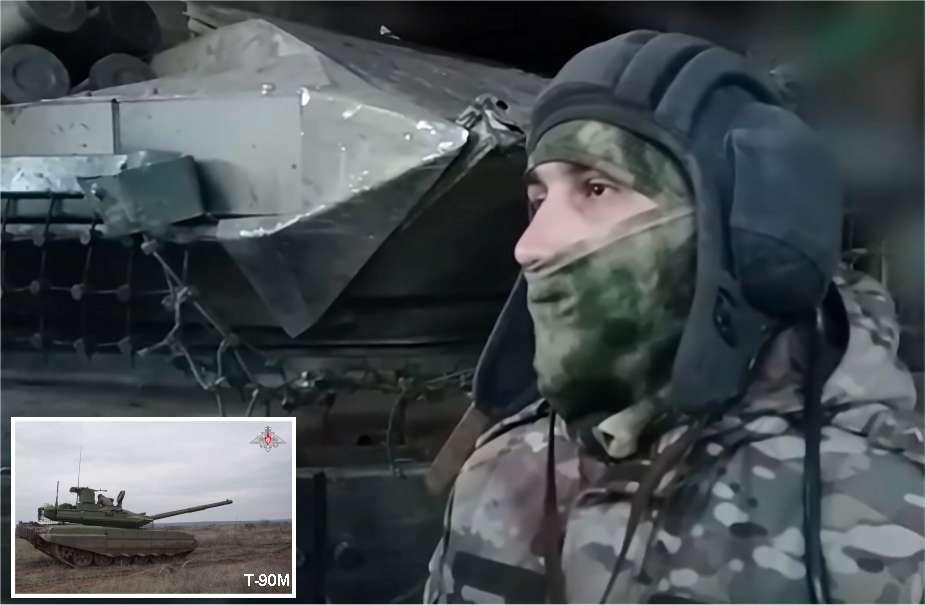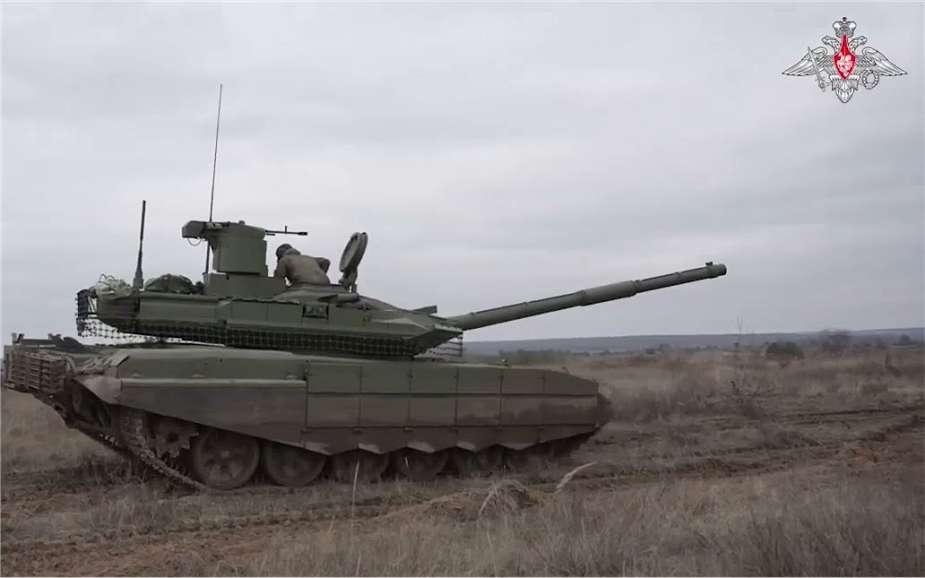A Russian T-90M Proryv tank achieved a remarkable feat by destroying a Ukrainian drone command center from an exceptional distance of 9 kilometers, as disclosed in a video interview by the Russian Ministry of Defense on March 22, 2024. The operation, which utilized information from drones, pinpointed the command post within an abandoned building—a key node for Ukrainian UAV operations—and eliminated it with the tank's powerful 125 mm smoothbore cannon.
Follow Army Recognition on Google News at this link

During an interview published by the Russian MoD, A Russian tanker of T-90M MBT explains the use of a drone to target a Ukrainian command post at a range of 9 km. (Picture source Russian MoD Video footage)
This extraordinary range of 9 kilometers stands out as significantly beyond the typical engagement distances for tanks, highlighting the T-90M's capabilities in leveraging both direct and indirect fire in combat scenarios.
The 125 mm cannon, which is a staple armament of the T-90M, is known for its versatility and destructive power. Capable of firing a range of ammunition types including armor-piercing fin-stabilized discarding sabot (APFSDS) rounds, high-explosive anti-tank (HEAT) rounds, and fragmentation projectiles, the cannon offers a comprehensive solution to various combat scenarios. Additionally, the cannon is capable of launching guided missiles, expanding its role on the battlefield to engage targets beyond the reach of conventional tank munitions.
With a maximum firing range that significantly exceeds the engagement distance in this operation, the 125 mm cannon reaffirms the strategic advantage of employing such advanced weaponry in executing long-range precision strikes. This capability not only enhances the tactical flexibility of the T-90M Proryv but also poses a formidable challenge to adversaries relying on unmanned systems and remote command posts for battlefield operations.
The Russian T-90M tank is also able to fire the 9M119M Refleks (NATO reporting name: AT-11 Sniper) anti-tank guided missiles through its main gun, enabling it to engage targets up to 5 kilometers away. This missile system is designed for precision strikes against tanks, low-flying aerial targets, and fortifications, further enhancing the T-90M's versatility on the battlefield.
The utilization of the 9M119M Refleks missile through the T-90M's main cannon represents a significant expansion of the tank's operational range and capabilities, allowing it to perform roles traditionally reserved for dedicated artillery units. This integration of missile technology enables the T-90M to conduct direct fire engagements at ranges that exceed those possible with conventional tank ammunition, as well as to assume an indirect fire role similar to self-propelled artillery, albeit with precise, guided munitions.
The engagement of the Ukrainian drone command center at a range of 9 kilometers, therefore, not only showcases the effectiveness of the T-90M tank in a direct combat role but also its adaptability in executing long-range precision strikes, blurring the lines between traditional tank warfare and the strategic use of guided missile systems.
The incorporation of drones alongside the latest generation of computerized fire control systems has significantly elevated the precision and accuracy of tank artillery in modern warfare. This technological convergence allows ground units, such as tanks, to effectively extend their situational awareness beyond the immediate battlefield, transforming their operational capabilities.

The T-90M is the latest Russian-made MBT Main Battle Tank deployed in Ukraine. (Picture source Russian MoD)
Drones, or Unmanned Aerial Vehicles (UAVs), serve as the eyes in the sky, providing critical real-time intelligence, surveillance, and reconnaissance (ISR). They are capable of identifying targets, assessing threats, and delivering high-resolution imagery to ground forces. This capability is crucial for tanks operating in diverse and complex environments, where direct line-of-sight to targets is often obstructed or the targets are beyond the effective range of conventional sensors.
When this aerially gathered intelligence is combined with the advanced computerized fire control systems of modern tanks, such as the T-90M Proryv, the effectiveness of these armored units is significantly enhanced. The fire control system (FCS) of a tank is a highly sophisticated network of sensors, computers, and aiming mechanisms designed to aid the crew in detecting, tracking, and engaging targets with high precision.
The T-90M Proryv, for instance, is equipped with an upgraded fire control system that integrates thermal imaging and digital ballistics computation capabilities. This system not only facilitates rapid target acquisition, even under adverse conditions or during night operations, but also calculates the most efficient firing solution based on a variety of parameters such as range, target movement, and environmental conditions. The FCS can adjust for factors like wind speed, humidity, and even barrel wear, to ensure that the projectile hits the target with the highest possible accuracy.
Moreover, the integration of drone intelligence into the tank's fire control system enables the crew to engage targets that are beyond their direct line of sight, effectively utilizing indirect fire in a manner similar to traditional artillery but with the precision and lethality of a tank round. This capability is further enhanced with the use of guided ammunition, such as anti-tank missiles, which can be directed towards targets identified and designated by drones, ensuring high-impact strikes against key enemy assets and fortifications.
In essence, the fusion of drone-acquired data with the advanced computational power of the T-90M's fire control system represents a significant leap in armored warfare. It not only increases the lethality and effectiveness of tanks on the battlefield but also considerably expands their operational roles, allowing for more strategic and flexible use of armored units in various combat scenarios.
News Russia Ukraine War
















